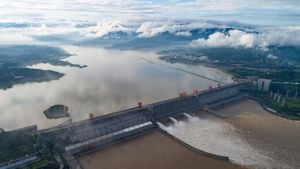Yellowstone National Park, renowned for its stunning geothermal features, has recently caught the attention of both the public and scientific community following a dramatic hydrothermal explosion at the Black Diamond Pool in the Biscuit Basin on July 23, 2024. Despite the chaos and large-scale debris accompanying the eruption, experts are emphasizing that this was a minor yet fascinating geological event rather than a precursor to volcanic activity.
The hydrothermal explosion sent rocks as large as three feet in diameter soaring into the air, damaged the surrounding boardwalks, and compelled park authorities to close the area for safety reasons. Eyewitness accounts described a plume of steam, mud, and rocks erupting unexpectedly, triggering widespread panic among park visitors who quickly sought safety.
Mike Poland, the scientist in charge at the Yellowstone Volcano Observatory, was quick to clarify the nature of the event. He stated, "This was a hydrothermal explosion and did not involve the volcanic system at all. This kind of activity happens a couple of times a year, on average, somewhere in Yellowstone, and can happen in any geyser basin in the park." While hydrothermal explosions are occurrences that naturalists have come to expect in Yellowstone, this particular event was far more noticeable due to its size and impact.
So, what precisely causes a hydrothermal explosion? These events occur when superheated water beneath the earth's crust turns into steam under immense pressure. Poland elaborated, "When water turns to steam, it expands over 1,000 times. When that happens in a confined space, the space can't hold the rapid expansion of steam and can cause explosions. It's a pressure cooker situation." This phenomenon of water turning to steam, commonly referred to as "flashing," is a process routinely observed in geysers across the park.
Despite the violent nature of the explosion, experts have categorized it as a relatively small event in the broader spectrum of hydrothermal explosions. Poland noted that numerous similar phenomena occur yearly, often in less accessible areas of the park that go unobserved by the public.
Reflecting on historical precedents, the eruption was compared to the infamous Porkchop Geyser explosion in 1989, which, although smaller in scale, still managed to throw rocks and debris around a short distance—thankfully, without causing injury. Poland recalled this earlier event, reinforcing that such explosions have been a documented part of Yellowstone's geothermal history.
The aftermath of the explosion raises intriguing questions about the future of the Black Diamond Pool and adjacent thermal features. Geologists are closely monitoring the site to understand any changes in behavior, temperature, and structural integrity. The blast may have permanently altered these thermal features, creating new dynamics within the hydrothermal system of Biscuit Basin.
The National Park Service confirmed that Biscuit Basin will remain closed for the remainder of the 2024 season while geologists assess the safety and stability of the thermal area. Poland indicated, "It seems likely that we will see a change in Black Diamond and the surrounding features. There was a big hole blown in the basin. That's going to change the plumbing system and may very well change their behavior and temperature.”
With the popular Biscuit Basin off-limits, other thermal areas and attractions within Yellowstone, like the Grand Loop Road, remain open to visitors, allowing them to continue experiencing the wonders of this unique landscape.
Scientific community perspectives surrounding hydrothermal explosions also delve into the challenges of prediction. Poland candidly mentioned the unpredictability of such events, noting that although there were no signs immediately preceding the Black Diamond eruption, the conditions for a hydrothermal explosion could arise at any point in the park’s dynamic thermal features. Eyewitnesses only noted a rush of steam from a nearby pool shortly before the explosion, highlighting the suddenness with which nature can unleash her power.
The broader geological context adds another layer of understanding. Yellowstone sits atop a massive supervolcano with deep magma reservoirs, capable of producing cataclysmic eruptions. However, it is important to note that the hydrothermal explosions do not indicate imminent volcanic activity. Poland confirmed, "The volcano remains at normal background levels of activity. There are no signs of changes that suggest an impending eruption or a significant seismic event nearby.”
In historical terms, the supervolcano beneath Yellowstone has produced some of the most significant eruptions known to science, with the last major eruption occurring approximately 631,000 years ago. It’s a sobering thought that while the park is characterized by its geothermal beauty, it has the capacity for future volcanic activity; yet, the time scales involved are vast, and any significant eruption will likely come with decades, if not centuries, of warning signs.
Returning to the immediate aftermath of the Black Diamond event, Poland reassures, "We're actively studying these explosions to understand their active nature within Yellowstone's geothermal landscape. The public need not be alarmed. These explosions, while they appear dramatic, are part and parcel of the geothermal tapestry of Yellowstone.”
Ultimately, the awe-inspiring beauty of Yellowstone National Park is enhanced by a deep understanding of its geologic features and processes, especially as visitors enjoy its breathtaking landscapes, geysers, and thermal pools. Scientists continue to demystify the conditions and behaviors involved while safely allowing us to appreciate the mesmerizing interplay between heat, water, and gas—the signature of Yellowstone's geothermal activity. Looking forward, both scientists and park-goers will keep their eyes on Biscuit Basin, anticipating what changes the recent explosion might reveal about the park's ever-evolving natural landscape.



